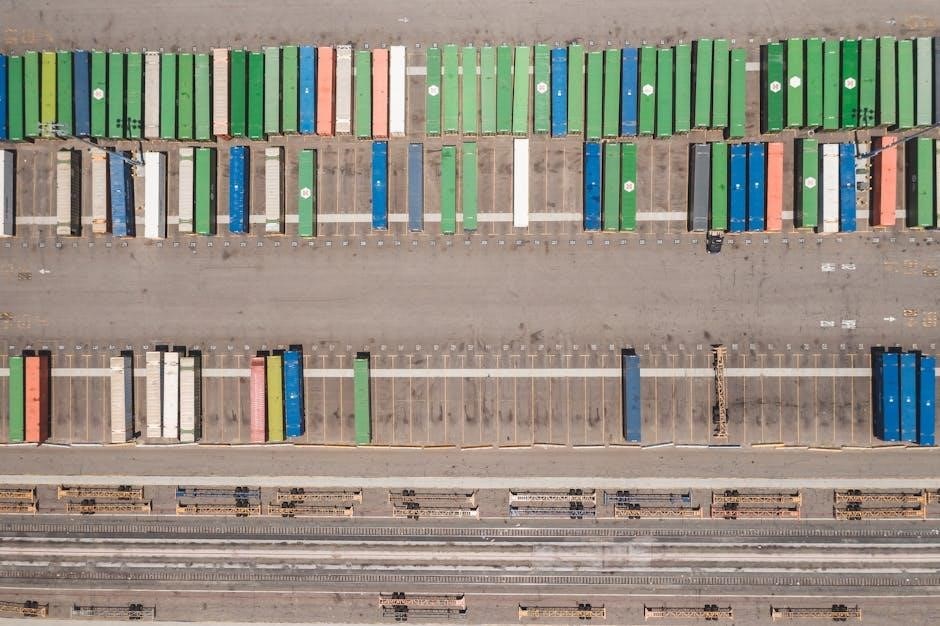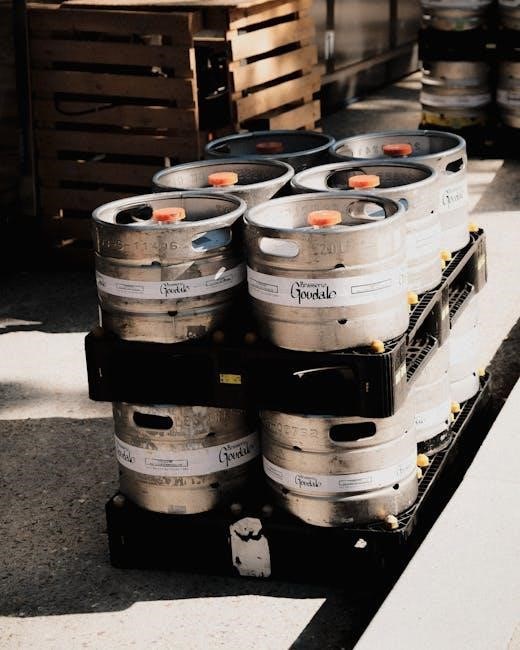Supply and demand zones are foundational concepts in technical analysis‚ representing areas where institutional traders drive price movements. These zones help identify potential trading opportunities and market trends‚ enabling traders to make informed decisions by understanding the balance between buying and selling pressure.
1;1 What Are Supply and Demand Zones?
Supply and demand zones are specific price levels in trading where significant buying or selling interest is concentrated. A supply zone is an area where sellers outnumber buyers‚ often leading to price drops‚ while a demand zone is where buyers dominate‚ typically driving prices up. These zones are identified through price action and institutional activity‚ helping traders anticipate potential market movements and make informed decisions. They are dynamic and context-dependent‚ influenced by market trends and sentiment.
1.2 Importance of Supply and Demand in Trading
Supply and demand zones are crucial for identifying high-probability trading opportunities. They reveal where institutional traders are likely placing orders‚ helping retail traders align with market sentiment. By focusing on these zones‚ traders can predict potential price reversals or continuations‚ reducing market noise. This approach allows for timely entries and exits‚ improving overall trading performance and consistency. Understanding these zones is essential for mastering technical analysis and executing successful trades in any financial market.

Understanding Market Structure
Market structure reveals how supply and demand zones influence price trends and breaks‚ helping traders identify potential trading opportunities. It explains how trends form and interact with these zones‚ aiding in strategic decision-making.
2.1 Break of Structure (BOS)
A Break of Structure (BOS) occurs when the market price breaks out of a established supply or demand zone‚ signaling a shift in market dynamics. This break indicates strong institutional interest‚ often leading to trend continuation. Traders use BOS to identify high-probability trading opportunities‚ as it reflects a change in dominance between buyers and sellers. Recognizing BOS patterns helps traders align their strategies with market sentiment and institutional flows‚ enhancing their ability to predict price movements effectively.
2.2 How Market Trends Interact with Supply and Demand Zones
Market trends interact with supply and demand zones by testing these areas as support or resistance. In an uptrend‚ demand zones act as support‚ while supply zones are broken‚ indicating strength. Conversely‚ in a downtrend‚ supply zones act as resistance‚ while demand zones are broken‚ signaling weakness. When a trend reverses‚ it often does so at these zones‚ making them critical for identifying potential turning points. Understanding this interaction helps traders align their strategies with the dominant market flow and institutional activity‚ improving their ability to predict price direction and timing.

Identifying Supply and Demand Zones
Identifying supply and demand zones involves locating areas of pending orders‚ where buying or selling interest is concentrated‚ driven by institutional activity and market structure.
3.1 Key Factors for Accurate Zone Identification
Accurate identification of supply and demand zones requires understanding market structure‚ recognizing pending orders‚ and analyzing institutional activity. Key factors include the speed of market return to zones‚ strength of buying or selling interest‚ and alignment with trend direction. Additionally‚ identifying zones near significant highs or lows and ensuring they are broad enough to attract substantial trading activity improves accuracy. These elements help traders pinpoint high-probability areas for entries and exits‚ enhancing trading effectiveness.
3.2 Role of Institutional Traders in Shaping Zones
Institutional traders play a pivotal role in shaping supply and demand zones by executing large orders that influence market structure. Their activity often creates zones where significant buying or selling interest exists. Smart money typically divides their trades into smaller‚ manageable portions to avoid disrupting prices‚ forming these zones. By identifying these areas‚ traders can align their strategies with institutional behavior‚ increasing the likelihood of consistent trading results and understanding the driving forces behind price movements.

Trading Strategies Using Supply and Demand Zones
Supply and demand zones enable traders to identify high-probability entry and exit points by aligning strategies with institutional activity‚ creating effective price action and order flow-based trades.
4.1 Price Action Trading with Supply and Demand Zones
Price action trading with supply and demand zones focuses on identifying key areas where institutional traders execute large orders. By analyzing these zones‚ traders can predict potential price reversals or continuations. Selling at supply zones and buying at demand zones aligns with institutional activity‚ offering high-probability trades. This strategy relies on understanding market structure and recognizing patterns like rallies or drops‚ enabling traders to enter and exit positions effectively. It emphasizes simplicity and precision‚ making it a popular choice among both novice and experienced traders.
4.2 How to Enter and Exit Trades Effectively
Entering and exiting trades effectively requires precise execution at supply and demand zones. Traders should wait for the price to revisit these zones‚ confirming with price action patterns like reversals or continuations. Buying at demand zones and selling at supply zones aligns with institutional activity. Use pending orders to execute trades at these key levels; Patience is crucial‚ as trades should only be taken when the price interacts with the zone. Always look to the left of the chart for context‚ ensuring the zone is fresh and untested. Confirmation through price action strengthens trade validity.

Advanced Concepts in Supply and Demand Trading
Advanced strategies involve analyzing order book data to identify trapped traders and understanding smart money’s role in shaping zones. These insights help refine trade execution.
5.1 Using Order Book Data to Identify Trapped Traders
Order book data reveals pending orders‚ highlighting areas where traders are trapped. By analyzing supply and demand zones‚ one can pinpoint where prices may reverse due to trapped traders closing positions. This strategy leverages institutional activity‚ identifying high-probability zones for execution. Traders use this data to anticipate reversals‚ enhancing their entry and exit strategies. Understanding trapped traders’ behavior through order book analysis is a powerful tool for making informed trading decisions and maximizing profitability.
5.2 The Role of Smart Money in Zone Creation
Smart money‚ typically institutional traders‚ plays a crucial role in forming supply and demand zones. They execute large orders in strategic areas‚ creating imbalances that define these zones. By splitting their trades into smaller‚ manageable positions‚ smart money influences price movements. Supply zones form when smart money sells‚ while demand zones emerge from their buying activity. Understanding their strategies helps traders identify high-probability zones‚ aligning with institutional actions for better trading outcomes. This insight into smart money behavior enhances the accuracy of supply and demand zone identification and trading decisions.

Case Studies and Real-World Examples
Real-world examples demonstrate how traders successfully use supply and demand zones to predict price reversals. Institutional traders often execute large orders in these zones‚ creating opportunities for profitable trades.
6.1 Successful Trades Using Supply and Demand Zones
Successful trades often result from accurately identifying supply and demand zones. Traders enter positions at demand zones where buying interest is strong and exit at supply zones where selling pressure is high. Institutional activity plays a crucial role‚ as smart money frequently executes trades within these zones. By focusing on zones with clear market structure breaks‚ traders can capitalize on high-probability setups‚ ensuring consistent and profitable outcomes in various market conditions.
6.2 Lessons Learned from Failed Trades
Failed trades often stem from overtrading or misidentifying supply and demand zones. Ignoring market context‚ such as trends or institutional activity‚ can lead to poor outcomes. Emotional decisions‚ like chasing price movements‚ exacerbate losses. Traders must learn to stick to their strategies and avoid impulsive actions. Proper risk management and disciplined execution are essential. Analyzing failed trades reveals the importance of patience and accurate zone identification‚ helping traders refine their strategies and improve future performance.

Psychological Aspects of Supply and Demand Trading
Emotional discipline is crucial in supply and demand trading. Fear‚ greed‚ and impulsive decisions can sabotage strategies. Maintaining a clear mindset ensures consistent execution and long-term success.
7.1 Understanding Market Sentiment
Market sentiment reflects the collective emotional tone of traders‚ influencing price movements. Bullish sentiment drives demand zones‚ while bearish sentiment fuels supply zones. Institutional traders often manipulate sentiment to trap retail traders‚ creating opportunities for savvy investors. Understanding sentiment shifts helps traders anticipate zone interactions and make informed decisions. Tools like support/resistance levels and order book data aid in analyzing sentiment‚ enabling traders to align their strategies with market psychology and institutional behavior.
7.2 Managing Emotions While Trading Zones
Emotional control is crucial when trading supply and demand zones. Fear and greed often lead to impulsive decisions‚ causing traders to deviate from their strategies. Effective emotional management involves adhering to predefined rules‚ maintaining discipline‚ and avoiding overtrading. Traders should focus on high-probability setups and accept that losses are part of the process. Developing a resilient mindset and using tools like journals to track performance can enhance emotional stability‚ ensuring consistent execution of trading plans and minimizing the impact of psychological biases.

Common Mistakes to Avoid
Avoid overtrading and misidentifying supply and demand zones. Ignoring market context and failing to validate zones leads to poor trading decisions. Stay disciplined and patient.
8.1 Overtrading and Zone Misidentification
Overtrading and misidentifying supply and demand zones are common pitfalls. Traders often enter too many trades‚ leading to poor risk management. Incorrectly marking zones without considering market context or institutional activity results in low-probability trades. It’s crucial to wait for clear zone confirmations and avoid impulsive decisions. Sticking to a disciplined approach ensures better outcomes and reduces emotional trading errors.

8.2 Ignoring Market Context
Ignoring market context is a critical mistake when trading supply and demand zones. Traders often fail to consider the broader trend‚ news events‚ or economic indicators‚ leading to misinterpretation of zone strength. Supply and demand zones must align with the overall market structure to be effective. Disregarding context can result in entering trades that appear promising but lack the necessary support or resistance to drive price movement.
Mastering supply and demand zones is key to enhancing trading accuracy. By understanding these zones‚ traders can make informed decisions‚ optimizing their strategies for consistent success.
9.1 Recap of Key Concepts

Supply and demand zones are critical areas where institutional traders execute large orders‚ influencing price movements. These zones reflect imbalances between buying and selling pressure‚ guiding traders to potential opportunities. Understanding market structure‚ such as break of structure (BOS)‚ helps identify these zones accurately.
Effective strategies involve trading price action within these zones‚ avoiding common mistakes like overtrading. Mastery requires discipline‚ patience‚ and a deep understanding of market dynamics to consistently achieve success in trading supply and demand zones.
9.2 Final Tips for Mastering Supply and Demand Trading
To excel in supply and demand trading‚ focus on consistency and discipline. Always look to the left of the chart to identify zones and confirm their strength. Avoid overtrading by adhering to your strategy and risk management plan. Continuously learn from failed trades to refine your skills. Stay patient and persistent‚ as mastery requires time and practice. Adapt to changing market conditions‚ and never stop improving your understanding of institutional behavior and market structure.
- Stay disciplined in your approach.
- Learn from every trade‚ whether successful or not.
- Adapt to evolving market dynamics.



